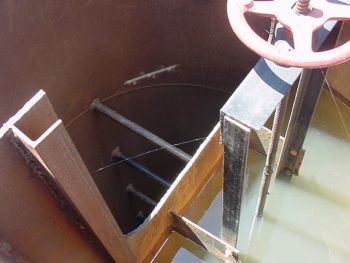Outlet Works

|
| Learn more about typical configurations of outlet works here |
“An outlet works is a combination of structures and equipment required for the safe operation and control of water released from a reservoir to serve various purposes (i.e., regulating stream flow and quality; releasing floodwater, providing irrigation, municipal, and/or industrial water)”.[1] Note that although outlet works are often necessary for the proper operation of a dam/reservoir system, they can create a distinct vulnerability in the system. Most outlet works include a conduit penetration and discontinuity within the dam or abutment/foundation, and therefore require careful and judicious design, inspection, and maintenance.
The outlet works is an essential component of any dam where the structure does not allow a continuous flow of water over the face of the dam. The discharge capacity and required outflows from the dam via the outlet works are determined by several factors including the purpose of the dam and/or federal and state regulation(s).
“Outlet works serve to regulate or release water impounded by a dam. It may release incoming flows at a reduced rate, as in the case of a detention dam; deliver inflows into canals or pipelines, as in the case of a diversion dam; or release stored-water at such rates as may be dictated by downstream needs, evacuation considerations, or a combination of multiple-purpose requirements”.[2]
“Outlet structures can be classified according to their purpose, their physical and structural arrangement, or their hydraulic operation… Low level outlets are provided to maintain downstream flows for all levels of the reservoir operational pool. The outlets may also serve to empty the reservoir to permit inspection, to make needed repairs, or to maintain the upstream face of the dam or other structures normally inundated… Outlet works may act as a flood-control regulator to release water temporarily stored in flood control storage space or to evacuate storage in anticipation of flood inflows. In this case, the outflow capacity should be able to release channel capacity, or higher. The flood control storage must be evacuated as rapidly as safely possible, in order to maintain flood reduction capacity”.[2]
Components of Outlet Works
“The components of outlet works, starting from the upstream end, typically consist of an approach channel, an intake structure, a conduit or a tunnel, a control gate chamber, (located in the intake structure, within the conduit, or at the downstream end of the conduit), an exit chute, an energy dissipater, and a discharge channel. Outlet works are frequently used to pass diversion flows during construction, regulate flood flows, aid in emptying the reservoir in an emergency condition, and permit reservoir lowering for inspections and special repairs”.[3]
The selection of the size, type, and location of the outlet works varies from one dam to the next and is highly dependent on the type of dam and the intended project purpose(s), the required discharge capacity, the specific hydrologic conditions, or hazard potential classification. When designing the layout and control mechanism of the conduit or tunnel used in the outlet works, two classifications are often used, each with their own advantages and disadvantages: downstream control and upstream control.
“The location of the control features within the outlet works affects the risk associated with internal erosion and backward erosion piping incidents. Downstream control features can allow pressurized conditions to occur in the upstream portion of the conduit. Pressurized conditions create a greater potential for water escaping under pressure, potentially eroding the surrounding earthfill or foundation soils. Careful consideration is required in selecting the location of control features”.[4] Downstream control allows for easier access to any valves or gates used to control the outlet works, as they can be contained within a galley inside the dam or in an appurtenant structure at the toe of the dam. This simplifies any work associated with inspecting, servicing, or replacing the gates or valves. Industry practice for outlet works with downstream controls is to provide provisions for upstream closure in case of an emergency.
Upstream control of the outlet works avoids the constant pressurization of the conduit or tunnel, and the risks associated with it, but has its own disadvantages. Upstream gates or valves are located underwater, meaning that they are more difficult to inspect, service, or replace.
Life Cycle of Outlet Works
Examples
![]() Learn more about outlet configuration
Learn more about outlet configuration
![]() Learn more about filters and drains for outlet works
Learn more about filters and drains for outlet works
![]() Learn more about accounting for energy dissipation at outlet works
Learn more about accounting for energy dissipation at outlet works
![]() Learn about the importance of having an operable reservoir drain system (DamFailures.org)
Learn about the importance of having an operable reservoir drain system (DamFailures.org)
Best Practices Resources
![]() Technical Manual: Outlet Works Energy Dissipators (FEMA P-679), FEMA, 2010
Technical Manual: Outlet Works Energy Dissipators (FEMA P-679), FEMA, 2010
![]() Technical Manual: Conduits through Embankment Dams (FEMA P-484), FEMA, 2005
Technical Manual: Conduits through Embankment Dams (FEMA P-484), FEMA, 2005
![]() Hydrologic Engineering Requirements for Reservoirs (EM 1110-2-1420), USACE, 1997
Hydrologic Engineering Requirements for Reservoirs (EM 1110-2-1420), USACE, 1997
![]() Design Standards No. 14: Appurtenant Structures for Dams (Ch. 1: Introduction), USBR, 2011
Design Standards No. 14: Appurtenant Structures for Dams (Ch. 1: Introduction), USBR, 2011
Trainings
![]() ASDSO Dam Owner Academy: Spillways & Outlet Works
ASDSO Dam Owner Academy: Spillways & Outlet Works
Citations:
- ↑ Technical Manual: Outlet Works Energy Dissipators, FEMA, 2010
- ↑ 2.0 2.1 EM 1110-2-1420 Hydrologic Engineering Requirements for Reservoirs, USACE, 1997
- ↑ EM 1110-2-2400 Structural Design and Evaluation of Outlet Works, USACE, 2003
- ↑ FEMA 484 Technical Manual: Conduits through Embankment Dams, FEMA, 2005
Revision ID: 6712
Revision Date: 03/17/2023
